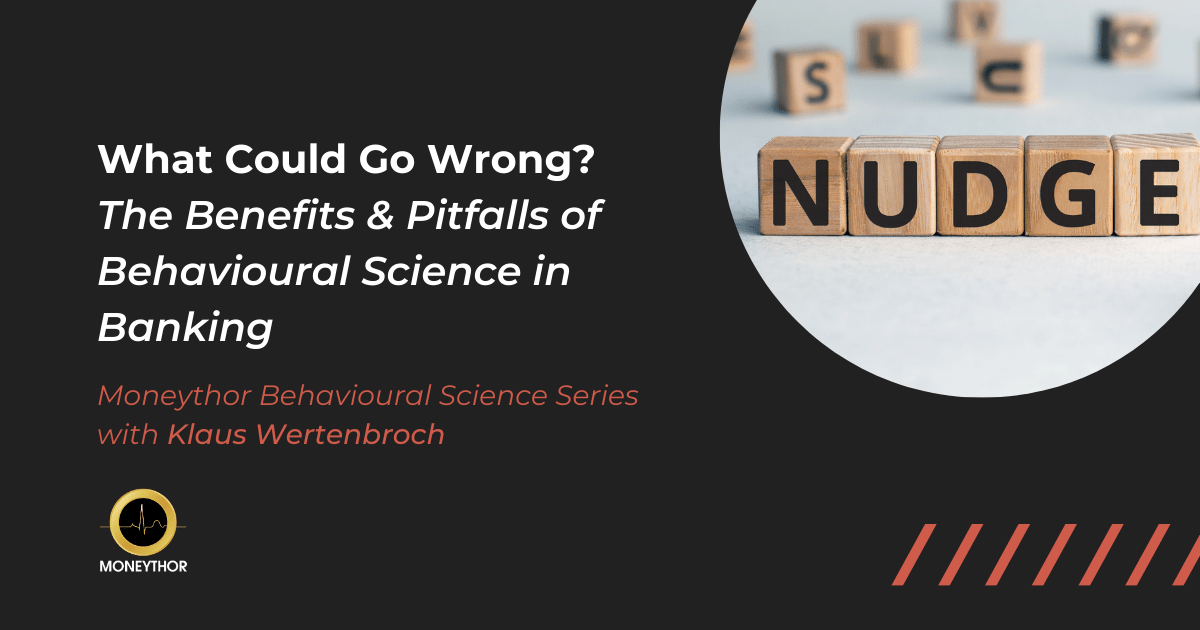Moneythor Behavioural Science Series with Klaus Wertenbroch.
Moneythor’s behavioural science series, a four-part collection of blogs, is based on interviews held with Klaus Wertenbroch, a renowned expert in behavioural economics and consumer-decision-making. Spread out over the course of the next 4 weeks, we will be delving into the topic of behavioural science in financial services, it’s benefits and pitfalls, the impact it can have on the financial wellbeing of customers and the role it will play in the future of banking.
Part 1 – When Banking and Behavioural Science Collide
Part 2 – What Could Go Wrong? The Benefits and Pitfalls of Behavioural Science Techniques.
Behavioural science in banking has proven effective in helping customers to change their behaviours and make decisions that positively impact their financial lives. How are banks implementing behavioural science techniques and what are the benefits and pitfalls of their application?
How are banks implementing behavioural science techniques?
According to Wertenbroch, “Behavioural scientists have shown how small changes in the context, in which customers make decisions, can help customers make better choices that improve their well-being. That idea has become known as nudging.”
Nudging has become a commonly used technique for engaging customers and can take many forms, one such way of nudging is framing. “Such nudges can be changes in how choices are framed, for example, whether customers have to opt into certain services or whether these services are provided as a default that customers have to opt out of if they do not wish to receive them.” Wertenbroch adds.
Digital transformation in banking has changed the way these nudges are delivered to customers. “Technology allows banks to deliver such nudges to individual customers exactly when they need them, depending on their financial needs. This is called personalised nudging. For example, algorithms can notify customers automatically when their account balances drop below predefined levels, which customers can set for themselves (opt in) or which banks can set for them (opt out). Such simple reminders may help bank customers with their financial planning.”
What are the benefits of applying behavioural science techniques?
“The benefits range from improving customer relationships with a bank’s brand by building feelings of trust, fairness and dignity to more tangible benefits such as improved financial well-being for the bank’s customers.” Wertenbroch says.
“For example, one of the biggest behavioural challenges that consumers face in making financial decisions, aside from perhaps lacking financial education (e.g. how big is the effect of compound interest?), is discounting the future consequences of their decisions in ways that do not conform to the rules of rationality.” He adds.
“Consumer preferences are typically present-biased. Consumers discount the more distant future disproportionately relative to the more proximate future. Put differently, they discount anything that happens in the more distant future too much compared to how they should discount it under the norms of rational choice. This leads to temptation – temptation to overspend in the present and to under save for the future, for instance, for retirement.”
“Some consumers are aware of their own present bias and try to curb it. Ulysses had his crew tie his hands to the mast of his ship so he wouldn’t be able to give in to the dangerous temptation of following the sirens’ beautiful voices and steer his ship in their direction. That is what behavioural economists call precommitment.”
Wertenbroch has experience with precommitment having researched the topic extensively. “Some of my own research was the first to document such precommitment in consumer behaviour. [Richard] Thaler, together with Shlomo Benartzi of UCLA, created a well-known precommitment method to help employees save more for retirement called Save-More-TomorrowTM. It allows employees to precommit to lock up part of their future pay raises in a retirement fund. Because this concerns only future raises, which have not materialized yet, employees are not yet tempted to overspend their money on current consumption. Thaler and Benartzi have shown that this method helped some employees quadruple their average savings rate from 3.5 percent to almost 14 percent in less than three-and-a-half years.”
Simple, personalised cues like nudges can have a lasting effect on the financial well-being of customers, but when done incorrectly or unethically these nudges can appear unethical.
What are the pitfalls of nudging?
When it comes to the ethics of nudging customers, Wertenbroch says “Implementing behavioural science techniques requires a clear goal. These techniques can either be used to take undue advantage of customers or help them improve their financial well-being. Therefore, banks need to be clear about the ethical ramifications of using these techniques.”
In order for banks to avoid any unethical-style nudging, Wertenbroch suggests “Users of behavioural science especially when implemented via technology, . . . need to understand their customers’ psychology and the underlying psychological principles that are being applied. For example, consumer researchers recently studied patient responses to diagnostic algorithms in medicine. Participants were told that diagnostics algorithms provide more accurate diagnosis than human doctors. Yet the findings showed that patients prefer to be seen by a human doctor rather than an algorithm because they felt that an algorithm couldn’t possibly take the uniqueness of their individual situation into account.”
“It is thus crucial to demonstrate to consumers that the use of behavioural insights is tailored to their own unique circumstances, treating them as an individual with dignity.” He concludes.
Check out part 3 of the series here
About Klaus Wertenbroch
Klaus Wertenbroch is a Professor of Marketing and Novartis Chaired Professor of Management and the Environment at INSEAD, one of the world’s leading and largest graduate business schools. Wertenbroch is an expert in behavioural economics and consumer-decision-making.


